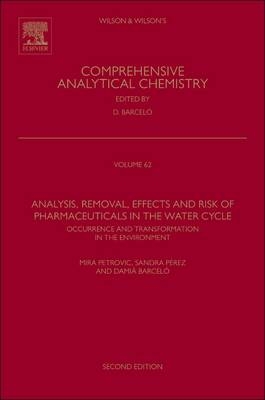
Analysis, Removal, Effects and Risk of Pharmaceuticals in the Water Cycle
Elsevier Science Ltd (Verlag)
978-0-444-62657-8 (ISBN)
Analysis, Removal, Effects and Risk of Pharmaceuticals in the Water Cycle provides an overview of the current analytical methods for trace determination of pharmaceuticals in environmental samples. The book also reviews the fate and occurrence of pharmaceuticals in the water cycle for their elimination in wastewater and drinking water treatment, focusing on the newest developments in treatment technologies, such as membrane bioreactors and advanced oxidation processes.
Pharmaceutically active substances are a class of new, so-called emerging contaminants that have raised great concern in recent years. Human and veterinary drugs are continuously being released into the environment mainly as a result of the manufacturing processes, the disposal of unused or expired products, and via excreta. The analytical methodology for the determination of trace pharmaceuticals in complex environmental matrices is still evolving, and the number of methods described in the literature has grown considerably. This volume leads the way, keeping chemistry students, toxicologists, engineers, wastewater managers and related professionals current with developments in this quickly evolving area.
Dr. Sandra Pérez Solsona, (80 publications and 17 book chapters; H-index=27), Barcelona (Spain). Since May 2005, research associate at the Institute of Environmental Assessment and Water Research IDÆA-CSIC in Barcelona (Spain). She has a Ph.D. in Chemistry from the University of Barcelona (2003). Postdoctoral researcher at the State University of New York at Buffalo (2003-2005). Her work is focused on studying the occurrence, distribution and degradation of pollutants in the aquatic environment. Use of advanced mass spectrometry techniques such as the hybrid techniques UPLC-QToF-MS and UPLC-QExactive-MS, for the structural elucidation of novel transformation products and metabolites of organic pollutants. She uses suspect screening and non-target approaches based on high resolution MS for the detection of polar emerging contaminants and for assessing their elimination and transformation in both natural processes and engineered systems. She has been involved in different EU projects (EMCO, SANDRINE and GLOBAQUA), NSF projects in EEUU and Spanish national projects (CEMAGUA and SCARCE). Principal investigator of CSI-Environment (Marie Curie Actions ITN CSI:Environment PITN-GA-2010-264329). Prof. dr. Barcelo Damia, Director of the Catalan Institute for Water Research (ICRA) and Professor at the Institute of Environmental Assessment and Water Research (IDAEA), Barcelona, Spain. His expertise is in water quality assessment and management, fate, risk and removal of emerging contaminants in wastewater treatment plants and analysis, fate and risk of emerging contaminants and nanomaterials in the aquatic environment. He published over 900 papers, 200 book chapters and has h index 91. He was a coordinator of several national and EU projects and at the moment he coordinates two EU projects: GLOBAQUA , on multiple stressors in the aquatic environment and SEA-on-a-CHIP, on the development of sensor technolgies for emerging contamaints in marine aquaculture. He is CoEditor in Chief of the journal Science of Total Environment and the book series Comprehensive Analytical Chemistry, both form Elsevier..
Introduction: Pharmaceuticals in the environment1. General introduction on pharmaceuticals, Peter Eichhorn2. Pharmaceuticals in the environment: Sources and their management, Christian DaughtonAnalysis of pharmaceuticals in the environment3. Prioritization: selection of contaminants to be monitored, Antoni Ginebreda4. Analysis of PhACs in aqueous samples (wastewater, surface water, groundwater, drinking water), Imma Ferrer5. Analysis of PhACs in solid environmental samples (soil, sediment, sludge), Sandra Babic6. Analysis of PhACs in biota, Sara Rodriguez7. Application of bioassays/biosensors for the analysis of pharmaceuticals in environmental samples, Roger GalveRemoval of pharmaceuticals in wastewater and drinking water treatment8. Removal of pharmaceuticals in wastewater treatment plants (conventional technology – CAS), Paola Verlicchi9. Removal of pharmaceuticals by membrane bioreactor technology (MBR), Rubén Reif López10. Removal of pharmaceuticals by UF, NF, RO, Davor Dolar11. Removal of pharmaceuticals by ozonation and advanced oxidation processes (AOP), Despo Fatta-Kassinos12. Removal by natural treatments (constructed wetlands), Victor Matamoros13. Removal of pharmaceuticals bank filtration and artificial recharge, Sung Kyu MaengFate and occurrence of pharmaceuticals in the environment14. Fate and occurrence of pharmaceuticals in the aquatic environment (surface water, sediment), Guang-Guo Ying15. Fate and occurrence of PhACs in the terrestrial environment, Silvia Diaz-Cruz16. Methods for elucidation of abiotic and biotic transformation pathways, Sandra PérezEffects and risk assessment17. Ecotoxicity of pharmaceuticals, Demetrio Raldua18. The effect of PhACs on biological communities in rivers: field studies, Lorenzo Proia19. Effect of antibiotics on microbial resistance, Jose Luis Balcazar20. Data evaluation for risks assessment purposes, Christina Ruden21. Conclusions and Needs for Future Research, Mira Petrovic
| Erscheint lt. Verlag | 26.11.2013 |
|---|---|
| Reihe/Serie | Comprehensive Analytical Chemistry |
| Verlagsort | Oxford |
| Sprache | englisch |
| Maße | 152 x 229 mm |
| Gewicht | 1000 g |
| Themenwelt | Naturwissenschaften ► Chemie ► Analytische Chemie |
| Technik ► Umwelttechnik / Biotechnologie | |
| ISBN-10 | 0-444-62657-3 / 0444626573 |
| ISBN-13 | 978-0-444-62657-8 / 9780444626578 |
| Zustand | Neuware |
| Haben Sie eine Frage zum Produkt? |
aus dem Bereich


